- Eastern Zimbabwe’s Marange diamond fields, discovered in 2006, have been touted by experts as the world’s biggest diamond find in generations.
- In 2008, government forces ruthlessly drove out illegal diamond miners, killing more than 200, according to human rights groups. Since then villagers suspected of illegal mining have been subject to torture and brutal extra-judicial punishments, rights groups allege. Mine waste has polluted local water sources, and some villagers relocated to make way for the mines have been resettled in starvation conditions.
- The Zimbabwean government recently ousted from the Marange fields all but one mining company, which it owns, leaving local people’s future in limbo.
On a sweltering February afternoon, the muffled cries of a baby resounded from a thatched pole and dagga hut in the Marange area of eastern Zimbabwe.
Villagers in this part of the country live in abject poverty, scraping together a living from subsistence farming, fishing, and selling mats made from baobab fiber. Yet hardly a few meters from their crudely built dwellings lie the rich Marange diamond fields.
The fields, also known as the Chiadzwa diamond fields, are located about 90 kilometres (56 miles) southwest of the eastern border city of Mutare. Covering approximately 80,000 hectares, they have been touted by experts as the world’s biggest diamond find in generations.
But villagers near Marange are praying; they are praying very hard that the diamonds will run out fast. The rich deposit of alluvial diamonds, which was discovered in 2006, has brought numerous woes to the more than 80,000 local people.
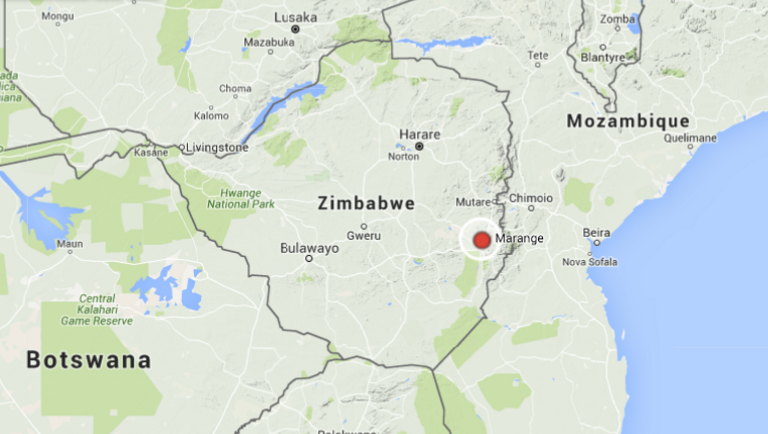
Forty-four-year-old Dorcas Chiadzwa of Chibiya Village in Marange could not hide her distaste for the diamonds.
“These diamonds are a problem,” Chiadzwa told Mongabay. “We are not benefiting anything from the diamonds; instead the diamonds have brought untold suffering to us.”
Her strong negative sentiments are shared by many people in the area, who at first rubbed their hands in glee when the diamonds were discovered, anticipating they would benefit from the gems.
Diamonds were discovered in the area in 2006, but mining was essentially a lawless free-for-all until 2008, when government forces ruthlessly drove out illegal diamond miners. Security forces killed more than 200 suspected illegal miners during the takeover, according to a report by the international investigative NGO Human Rights Watch.

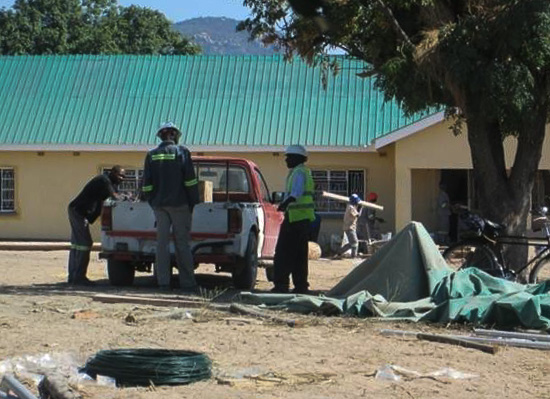
Until recently five companies have held licenses to mine the diamonds: Marange Resources, Anjin Investments, Jinan Mining, Mbada Diamonds, and Diamond Mining Corporation. (The Zimbabwean government owns Marange Resources fully and has a stake in the other companies. The remainders of Anjin and Jinan are owned by Chinese companies, Mbada by a South African company, and Diamond Mining Corporation by Lebanese investors.)
Local and international human rights groups say that since the government takeover in 2008 the Marange diamond fields have become an outpost of terror and human rights violations perpetrated by soldiers, the police, and security guards manning the vast diamond fields. They have also polluted local water sources and displaced villagers into starvation conditions in crumbling housing with no source of income.
Now the government, in a recent move to take over diamond-mining operations nationally, has ousted four of the companies, leaving local people’s future in limbo.
Torture and pollution
A local NGO called the Centre for Research and Development (CRD) has been monitoring and documenting human rights violations in Marange since the diamonds were discovered in 2006.
Security is tight around the Marange diamond fields. Even so, hard-up locals still try to sneak in to illegally mine the diamonds. Some of those caught, as well as others merely suspected of illegal mining, have been taken to a place within the diamond fields known as the Diamond Base, where they were tortured for days and released without formal charges, according to a 2014 report by CRD.
The NGO has documented dozens of cases in which security guards beat and set dogs on suspected illegal miners. (Warning: link contains graphic images of injuries.) Several suspected panners have been viciously mauled and some left for dead.
“On average 80 to 120 victims of abuses were recorded in Marange between 2012 and 2014. In 2015 we recorded about…60 cases,” CRD’s acting director, James Mupfumi, told Mongabay.
Mupfumi said his organisation assisted the victims with counseling and directed some to the NGO Zimbabwe Lawyers for Human Rights (ZLHR) for legal advice.
“We also assist some victims to report to their cases to police, directing them for medical treatment,” he said.
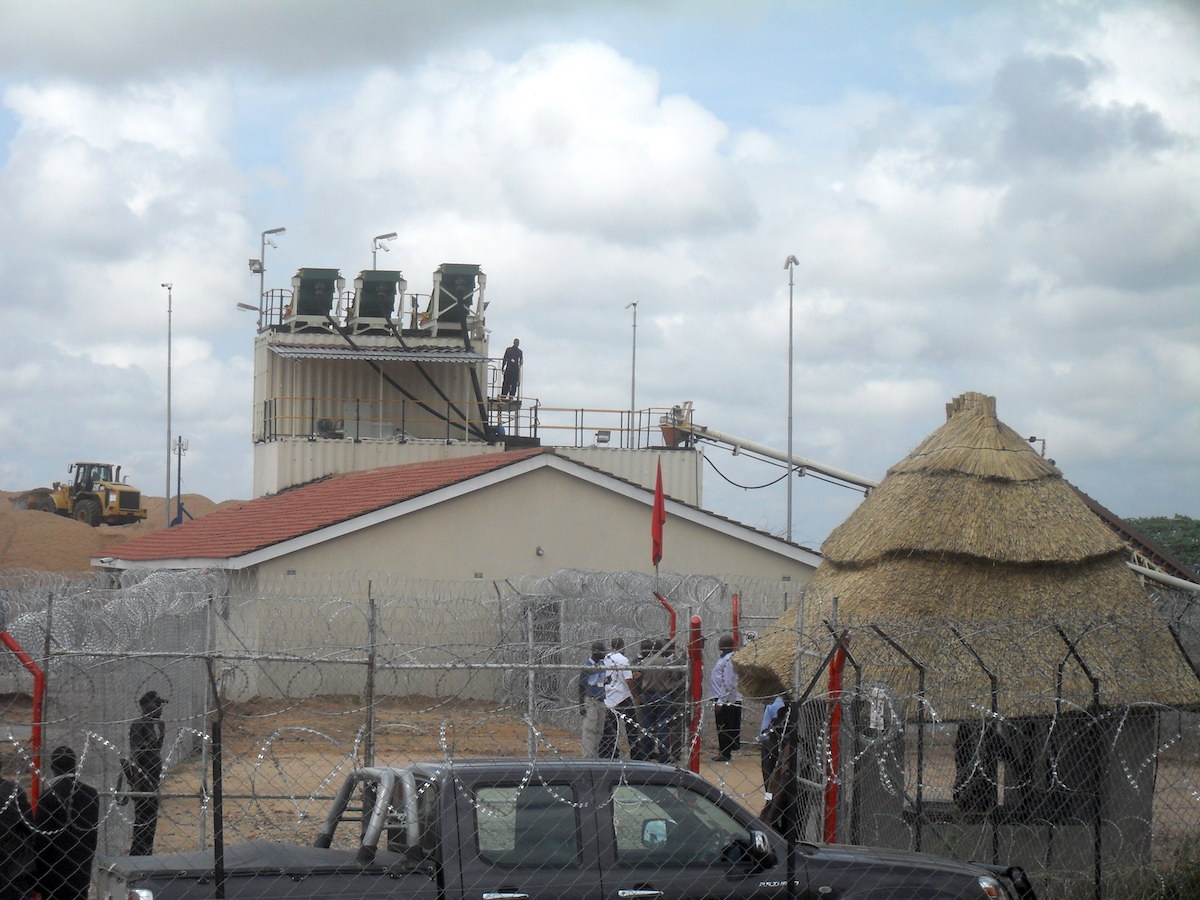
In 2014, 40 villagers were abducted while watching a soccer match on television at a business center near the mine. They were driven to a police base and tortured by police on allegations that they were illegal diamond panners, according to CRD, citing a news report.
“I was not in the protected area of Chiadzwa and I had no diamonds on me. If they had any suspicions, they could have taken me to the nearest police station for questioning and I would have defended myself in the court of law upon arrest. I was abducted at gun point and assaulted at the diamond base for a crime that I did not commit. These people are indiscriminately committing heinous crimes at the diamond base against defenseless citizens,” CRD quotes one 2014 victim as saying.
“We no longer move freely here in Marange. Police move around searching door to door for illegal diamond miners and innocent people have also been caught in [the] dragnet,” Chiadzwa told Mongabay.
Villagers also complain that companies have been polluting local rivers and other water sources.
“Our water is dirty and tainted with dangerous chemicals. We don’t even know the long-term effects of using the contaminated water,” she said.
More than 1,000 cattle have died after drinking water contaminated by the diamond mining companies, and people have gotten sick after drinking or coming into contact with the contaminated water. A report commissioned by the NGO the Zimbabwe Environmental Law Association of water quality on two rivers downstream from the mine revealed siltation and bacterial, chemical, and heavy-metal pollution, including the presence of potentially cancer-causing agents that are constituents of a chemical used to extract diamonds.
Between 500,000 and 700,000 people may be affected by pollution from the diamond mine, according to the Environmental Justice Atlas, a project developed by researchers from the Autonomous University of Barcelona.
No benefit to locals
Various figures have been bandied about estimating diamond production at Marange. One credible estimate put production in 2013 at 16.9 million carats, which translated to 13 percent of the global rough diamond supply. But numbers appear to have fallen off since then, to an estimated 6 to 10 million carats in 2015 worth perhaps as much as $300 million.
However, despite the documented human rights violations, the Kimberley Process Certification Scheme — a UN-backed process established in 2003 to prevent conflict diamonds from entering the mainstream rough-diamond market — cleared the Marange diamonds for export in 2011.
The Kimberley Process (KP) defines conflict diamonds as “rough diamonds used by rebel movements or their allies to finance conflict aimed at undermining legitimate governments.” As such the Marange diamonds fall outside this definition.
“Attempts by civil society groups and other progressive stakeholders in the KP to redefine and broaden the term conflict diamonds to ‘rough diamonds that fund armed conflict and human right violations’ has been met with suspicion and resistance by the Zimbabwean government,” the CRD writes in a report.
The diamond mining in Marange has been shrouded in secrecy and diamonds worth millions of dollars were shunted out of the area with no benefit to the local people. Very little revenue has ended up in government coffers either and it remains a mystery where the revenue from the diamonds has been going.

In 2012 the diamond companies pledged to deposit $50 million into a local community trust called Zimunya-Marange Share Ownership Trust. According to the local government newspaper The Herald, the trust was set up under a national regulation passed in 2010 that provides that “local communities whose natural resources are being exploited by any ‘qualifying business’ must be guaranteed shareholding in such business.”
However, the companies have paid nothing into the trust so far, and in fact denied ever pledging the $50 million when they appeared before parliament in 2014, according to The Herald’s story.
And villagers’ hopes of benefiting from the diamonds have faded. Instead they are counting their losses.
Mining companies reshuffled
Without notice in February this year, the government stopped four of the five diamond companies from mining in Marange. The companies were resisting moves by the government to consolidate them — as well as nearly all diamond companies operating throughout the country — into one entity, the Zimbabwe Consolidated Diamond Company.
Only Marange Resources, which is wholly owned by the government, will continue to mine in the area. The Zimbabwe Consolidated Diamond Company is expected to be fully constituted in March this year.
“All the licences of the affected mines had expired and they did not bother to renew them,” Mines and Mining Development Minister Walter Chidhakwa told a news conference in the capital, Harare. “Since their licences had expired, they no longer have title or any reason to continue mining. The companies were totally against their consolidation into one mine. We tried to engage them in a number of extra-ordinary general meetings with their shareholders, but they remained adamant.”

After the companies were kicked out security forces moved in to provide security and up to 50 illegal panners were arrested as they attempted to sneak into the diamond fields.
But a local traditional leader, Headman Chiadzwa, told the ministers during the visit that members of the security services were demanding bribes and allowed some panners into the diamond fields.
“We are concerned because police are being paid $10 to allow panners to sneak into the diamond fields. This should stop,” Headman Chiadzwa told the Manica Post.
Villagers were skeptical that the consolidation of the diamond mining companies would yield any benefits.
Malvern Mudiwa, a villager who heads a pressure group called Marange Development Trust, bluntly told Mongabay the diamonds were a curse.
“The situation in Marange is terrible, the companies were discharging toxic waste into Chengu River which flows into Singwizi and then into Save (Sabi) River. Villagers are worried and they have been deprived of their sources of water for bathing, washing, and irrigation. These diamonds are a curse,” Mudiwa said.
He added: “We are going to be worse off after the mining companies have gone because they are leaving massive land degradation. We have cases of people and livestock falling into unprotected open pits left by the mining companies.”
But the CRD’s director Mupfumi told Mongabay that transparency might be enhanced by reducing the number of players in the local diamond industry.
“However due diligence is needed in transforming the industry from opacity to accountable mining practices,” Mupfumi said.
Mupfumi called on the government to immediately withdraw all military personnel in Marange diamond fields and to strengthen police operations in order to maintain law and order during the transitional period.
“We also call for immediate freezing of all company assets in the diamond fields and initiate due diligence processes. Companies must submit audited reports and government must have them published during this period,” Mupfumi said. “Government must investigate all diamond executives involved in Marange diamond mining and hold them to account for resource plunder and human rights violations.”
He added that the government must expedite the law-making process for the diamond industry and come up with a law that adopts world best practices to guide diamond operations.
A place called ArdaTransau
Some villagers were relocated to make way for the diamond mines, but they are not faring any better than those that remained near the mines. Dumped at a desolate government farm called ArdaTransau about 40 kilometres (25 miles) northwest of Mutare, the villagers are now wallowing in poverty and hunger. At least 1,000 families were resettled to the farm since 2009.
ArdaTransau is a 12,000-hectare farm formerly owned by the Agricultural and Rural Development Authority. It has not operated for more than 10 years owing to various challenges.
Viewed from afar, the new settlement looks like an upscale rural development with nice houses newly constructed by the diamond companies. However, the houses were built using substandard materials and just five years after construction most are on the brink of collapse. Gaping cracks were visible on a number of houses on a visit this February.
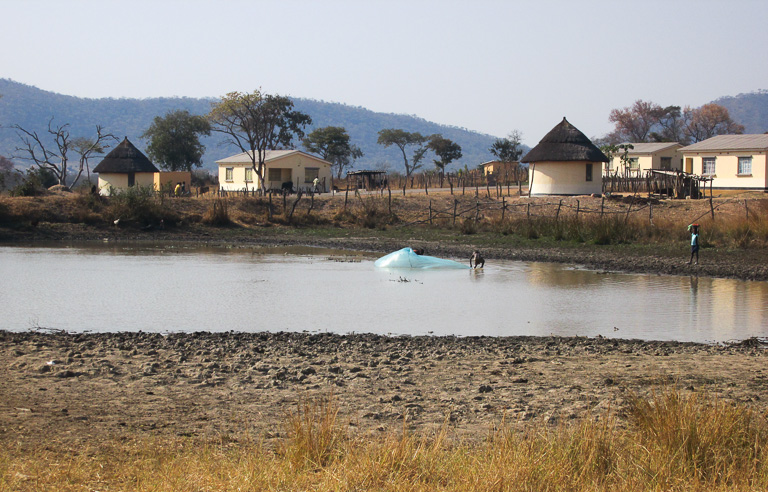
According to the Provincial Affairs Minister for Manicaland province, Mandi Chimene, each diamond company had pledged to build a primary and secondary school and a clinic, and to provide clean water and electricity for the relocated families.

The diamond companies had also promised the relocated villagers various income-generating projects, including irrigation for farming and poultry and pig operations, but nothing came through.
Without a source of livelihood, villagers are sliding deeper into the abyss of poverty and the current El Niño-induced drought hitting Zimbabwe and other countries in southern Africa has made things even worse.
The country’s Vice President, Emmerson Mnangagwa, recently said Zimbabwe needs at least $1.6 billion in foreign aid to feed nearly 3 million people across the country this year as a result of the drought, Reuters reported.
A villager relocated to ArdaTransau, Causemore Musaamba, told Mongabay that many people at the new settlement were on the brink of starvation.
“We don’t have food. With the current drought life has been tough for us. We have nothing. We have no drinking water,” said Musaamba, a father of seven.
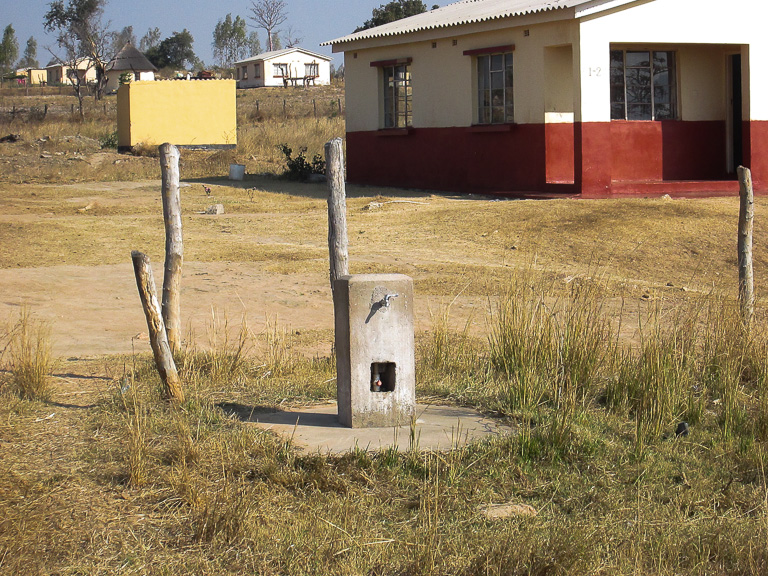
Many people at ArdaTransau are now surviving by selling firewood illegally at the nearby Odzi Business Centre.
Musaamba said with the closure of mining companies at Marange diamond fields, the villagers were no longer hoping to get any assistance from the diamond companies.
“The companies had promised us a lot of things but we don’t think these things will be fulfilled,” he said.
If the companies had deposited the $50 million into the Zimunya-Marange Share Ownership Trust as per their pledges, some of the money would have been used to kick start income-generating projects at ArdaTransau and in the villages near the mines.
However, Chidhakwa told the Zimbabwe parliament late last year that the Zimbabwe Consolidated Diamond Company would inherit both the assets and liabilities of the previous diamond companies, and will honour the rights of the community share ownership trusts, according to news reports.
“I want to assure our communities out there that the process of consolidation itself does not do away with the commitment of community share ownership trusts that are in place.”
For now, locals living in the shadow of the Marange diamond fields are waiting to see whether the change in management will improve their lot.

Citations
- HRW (2009). Diamonds in the Rough: Human Rights Abuses in the Marange Diamond Fields of Zimbabwe. New York, USA: Human Rights Watch.
- CRD (2014). Conflictive Marange diamonds implicates the uniformed forces in ongoing human rights violations. Mutare, Zimbabwe: Centre for Research and Development.
- ZELA (2012). Report on the scientific investigation of the impact of marange diamond mining operations on water quality in the save and odzi rivers: including assessment of the health, environmental and livelihoods impacts. Harare, Zimbabwe: Zimbabwe Environmental Law Association.
- CNRG (2014). Marange relocations lead to new poverty. Zimbabwe: Centre for Natural Resource Governance.